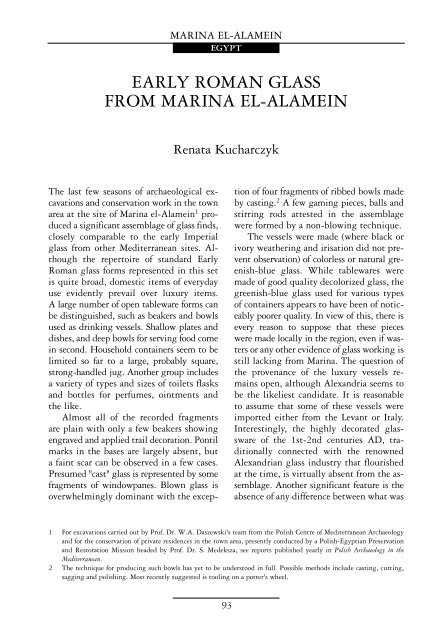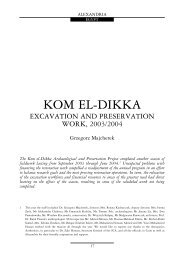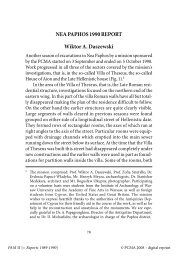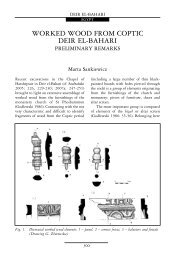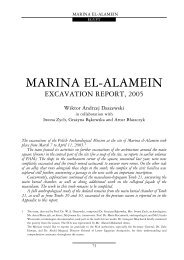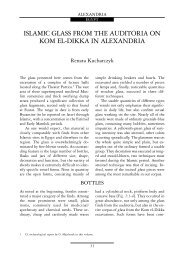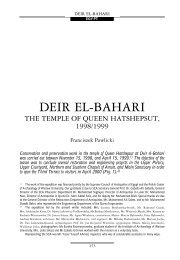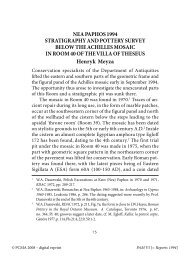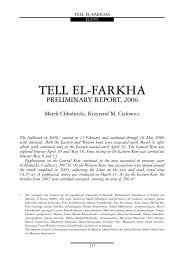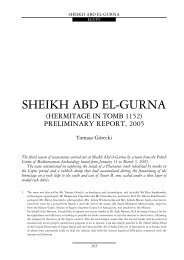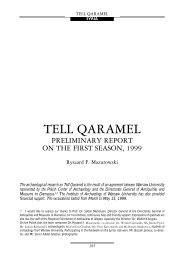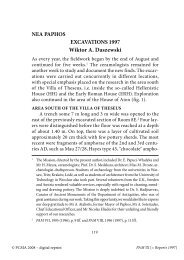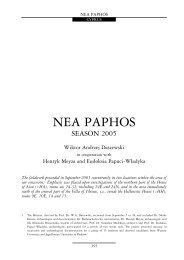EARLY ROMAN GLASS FROM MARINA EL-ALAMEIN
EARLY ROMAN GLASS FROM MARINA EL-ALAMEIN
EARLY ROMAN GLASS FROM MARINA EL-ALAMEIN
You also want an ePaper? Increase the reach of your titles
YUMPU automatically turns print PDFs into web optimized ePapers that Google loves.
<strong>MARINA</strong> <strong>EL</strong>-<strong>ALAMEIN</strong><br />
EGYPT<br />
<strong>EARLY</strong> <strong>ROMAN</strong> <strong>GLASS</strong><br />
<strong>FROM</strong> <strong>MARINA</strong> <strong>EL</strong>-<strong>ALAMEIN</strong><br />
Renata Kucharczyk<br />
The last few seasons of archaeological excavations<br />
and conservation work in the town<br />
area at the site of Marina el-Alamein 1 produced<br />
a significant assemblage of glass finds,<br />
closely comparable to the early Imperial<br />
glass from other Mediterranean sites. Although<br />
the repertoire of standard Early<br />
Roman glass forms represented in this set<br />
is quite broad, domestic items of everyday<br />
use evidently prevail over luxury items.<br />
A large number of open tableware forms can<br />
be distinguished, such as beakers and bowls<br />
used as drinking vessels. Shallow plates and<br />
dishes, and deep bowls for serving food come<br />
in second. Household containers seem to be<br />
limited so far to a large, probably square,<br />
strong-handled jug. Another group includes<br />
a variety of types and sizes of toilets flasks<br />
and bottles for perfumes, ointments and<br />
the like.<br />
Almost all of the recorded fragments<br />
are plain with only a few beakers showing<br />
engraved and applied trail decoration. Pontil<br />
marks in the bases are largely absent, but<br />
a faint scar can be observed in a few cases.<br />
Presumed "cast" glass is represented by some<br />
fragments of windowpanes. Blown glass is<br />
overwhelmingly dominant with the exception<br />
of four fragments of ribbed bowls made<br />
by casting. 2 A few gaming pieces, balls and<br />
stirring rods attested in the assemblage<br />
were formed by a non-blowing technique.<br />
The vessels were made (where black or<br />
ivory weathering and irisation did not prevent<br />
observation) of colorless or natural greenish-blue<br />
glass. While tablewares were<br />
made of good quality decolorized glass, the<br />
greenish-blue glass used for various types<br />
of containers appears to have been of noticeably<br />
poorer quality. In view of this, there is<br />
every reason to suppose that these pieces<br />
were made locally in the region, even if wasters<br />
or any other evidence of glass working is<br />
still lacking from Marina. The question of<br />
the provenance of the luxury vessels remains<br />
open, although Alexandria seems to<br />
be the likeliest candidate. It is reasonable<br />
to assume that some of these vessels were<br />
imported either from the Levant or Italy.<br />
Interestingly, the highly decorated glassware<br />
of the 1st-2nd centuries AD, traditionally<br />
connected with the renowned<br />
Alexandrian glass industry that flourished<br />
at the time, is virtually absent from the assemblage.<br />
Another significant feature is the<br />
absence of any difference between what was<br />
1 For excavations carried out by Prof. Dr. W.A. Daszewski's team from the Polish Centre of Mediterranean Archaeology<br />
and for the conservation of private residences in the town area, presently conducted by a Polish-Egyptian Preservation<br />
and Restoration Mission headed by Prof. Dr. S. Medeksza, see reports published yearly in Polish Archaeology in the<br />
Mediterranean.<br />
2 The technique for producing such bowls has yet to be understood in full. Possible methods include casting, cutting,<br />
sagging and polishing. Most recently suggested is tooling on a potter's wheel.<br />
93
<strong>MARINA</strong> <strong>EL</strong>-<strong>ALAMEIN</strong><br />
EGYPT<br />
found in domestic and in burial contexts.<br />
The inhabitants of this town apparently<br />
buried their dead with the same glass<br />
vessels they used in the household.<br />
The glass dates generally from the 1st<br />
to 3rd centuries with a concentration in<br />
the 1st and 2nd century AD.<br />
Drinking vessels predominate in our assemblage.<br />
The relatively large numbers of<br />
indented beakers with four indents (Isings<br />
form 32) 3 prove that they satisfied a widespread<br />
need. All are either colorless or have<br />
a slight yellowish-green tinge. They are cylindrical<br />
in shape with unworked, crackedoff<br />
rims and a constriction just below<br />
[Fig. 1:2]. Only a few fragments were<br />
finished with a vertical fire-rounded rim<br />
[Fig. 1:3]. The chief characteristic of these<br />
vessels is the contrast between the thin<br />
walls and easily recognizable bases. These<br />
bases are flat or kick-up, and noticeably<br />
thick, almost square, without pontil mark<br />
[Fig. 1:1]. This very popular form of what<br />
was essentially a utilitarian object, although<br />
usually considered of Eastern origin, enjoyed<br />
wide distribution. Find places extend from<br />
Britain to Egypt. In Egypt, specimens occurred<br />
at Karanis 4 and they are not uncommon<br />
in the Red Sea region. 5 Among<br />
the beaker sherds observed in the assemblage,<br />
there are a few with faintly engraved<br />
horizontal wheel-cut lines encircling the<br />
upper wall. They might have belonged to<br />
a different type of the beaker, probably<br />
a tall, thin-walled form with conical body<br />
and flaring foot [Fig. 1:4,6], which was also<br />
identified among the sherds.6<br />
The few out of the ordinary pieces in this<br />
assemblage are all the more conspicuous<br />
because of the prevalent simplicity of forms<br />
displayed by the glass vessels from the excavations.<br />
One such luxury item is the pillar-moulded<br />
bowl, a hallmark of 1st century<br />
AD glass practically all over the Roman<br />
Empire. Only three fragments of such vessels<br />
were recovered [e.g. Fig. 1:7]. They<br />
were made of decolorized glass, and have<br />
an extremely faint greenish or bluish tinge.<br />
The limited number of examples from<br />
Marina may suggest non-Egyptian origin<br />
and may support Harden's opinion that<br />
although these bowls are considered an<br />
Eastern Mediterranean form, they were rare<br />
in Egypt. Apart from Alexandria, the form<br />
has been reported from Karanis 7 and Tell<br />
el-Balamun. 8 Numerous pieces were excavated<br />
in the Red Sea region. 9 Considerable<br />
quantities of this well-known type are common<br />
in a wide geographical distribution<br />
across the Mediterranean and even far up<br />
into the Black Sea area.<br />
Vessels with applied fillets, as they are<br />
known, are generally connected with the<br />
shallow bowl or deep dish type. Two pieces<br />
with this plastic ornamentation (Isings form<br />
43) were recovered [e.g. Fig. 1:8]. 10 The<br />
3 C. Isings, Roman Glass from Dated Finds (Jakarta 1957), 46-47.<br />
4 D. Harden, Roman Glass from Karanis (Ann Arbor), 1936, Pl. XV : 376, 391, 393.<br />
5 J.-P. Brun,"Les objects en verre", in H. Cuvigny (éd.), La route de Myos Hormos (IFAO: Cairo 2003), 516, Fig. 239:11.<br />
The beakers from Quseir al-Qadim display a certain variety of body shapes, cf. C. Meyer, Glass from Quseir al-Qadim<br />
and the Indian Ocean Trade (Chicago 1992), 27-28, Pl. 8: 149-166.<br />
6 Such a beaker has been published from Cyprus, cf. A. Oliver Jr., "The Glass", in La Nécropole D'Amathonte. Tombes<br />
113-367, Études Chypriotes XIV (Nicosie 1992), 106, 121:T.199/28; Brun, op. cit., 516-517, Fig. 239:7.<br />
7 Cf. Harden, op. cit., 118-119, one fragment.<br />
8 A. J. Spencer, Excavations at Tell el-Balamun (1991-1994) (London 1996), 18, Pl. 87:20.<br />
9 Quseir: Meyer, op. cit., 17-18, Pl. 1:1-25; Berenice: S.E. Sidebotham and W.Z. Wendrich, Preliminary Report of the 1994<br />
Excavations at Berenike (Leiden 1995), 37-38, Fig. 16; Maximianon: Jean-Pierre Brun, op.cit., 517, Fig. 240: 24.<br />
10 Isings, op. cit., 59.<br />
94
<strong>MARINA</strong> <strong>EL</strong>-<strong>ALAMEIN</strong><br />
EGYPT<br />
bands are attached in pairs at opposite sites<br />
of the rim and tooled into a series of ribs.<br />
They imitate handles. One fragment is<br />
noticeably big and may belong to a shallow<br />
plate. The estimated diameter of the crimped<br />
band attached to the almost horizontal<br />
rim is about 12 cm. Parallels are fairly numerous.<br />
Vessels with this plastic element<br />
have been attested over a wide area of the<br />
Mediterranean and even as far afield as the<br />
Black Sea coast.<br />
Other tableware forms are represented<br />
only by rim and base fragments [Fig. 2].<br />
Two well-known types are prevalent among<br />
the bases. A ring base of colorless glass<br />
with a slight greenish tinge, common on<br />
a variety of vessel shapes, was in our case<br />
part of shallow bowls or plates, one of the<br />
Fig. 1. Beakers (1-6), pillar-moulded bowl (7) and dish with applied fillet (8)<br />
(Drawing and inking R. Kucharczyk)<br />
95
<strong>MARINA</strong> <strong>EL</strong>-<strong>ALAMEIN</strong><br />
EGYPT<br />
most common household items in Roman<br />
times [Fig. 2:1-3]. Bases of this type were<br />
recorded at Karanis, 11 Quseir al-Qadim, 12<br />
Maximianon. 13 High bases recovered in<br />
quantity from the site [Fig. 2:4-6] must<br />
have been used for a variety of shapes and<br />
sizes. They can be connected with both<br />
shallow dishes and broad plates and deep<br />
bowls. Bases were rather not made at the<br />
same time with the vessel, but were attached<br />
later by "post" technique. 14 Their<br />
characteristic feature is an inner ridge, made<br />
by the thrust of the base from below.<br />
(A hypothetical reconstruction of the whole<br />
vessel was made with some rims identified<br />
among the sherds [Fig. 2:7]). Such forms<br />
are well attested at Kom el-Dikka, 15<br />
Karanis 16 and Eastern Desert sites. 17 One<br />
unbroken bowl has been published from<br />
Dush. 18<br />
Bottles and flask of various kinds and<br />
sizes constituted the second most common<br />
group of glass finds in Marina [Fig. 3:1-9].<br />
The majority belongs to long-necked unguentaria,<br />
the most widespread and constant<br />
shape in early Roman glass. Such bottles<br />
were used by the living as containers<br />
for perfume, sweet-scented essences and<br />
other valuable volatile liquids, probably<br />
also for medical substances and oil. Some of<br />
them still contain traces of unguents. These<br />
receptacles, commonly referred to also as<br />
"tear bottles", were given in great numbers<br />
as gifts to the dead in burial offerings. 19<br />
They are cheap, quickly and carelessly made.<br />
All such specimens from the Marina site<br />
were made of poor quality, natural green<br />
glass with bubbles (although it is often hard<br />
to see the glass under the black weathering).<br />
The body tends to be pear-shaped,<br />
conical or oval. The long neck is cylindrical<br />
with an outsplayed, wide, flat, folded rim.<br />
In most cases the bases are entirely solid,<br />
serving as ballast for the vessel with its<br />
tube-shaped interior of very small capacity<br />
[Fig. 3:1]. Some, however, feature a hollow<br />
base [Fig. 3:2-3]. This long-lived and massproduced<br />
type is not restricted to the Eastern<br />
Mediterranean. Of the numerous parallels,<br />
suffice it to mention the bottles excavated<br />
at Kom el-Dikka, as well as finds<br />
from Karanis, 20 the Roman cemetery at<br />
Douch 21 and Quseir. 22<br />
Another type of toilet container is represented<br />
by four fragments of flasks<br />
with a thick, distinctive "collar-like" rim<br />
[Fig. 3:4-5]. They have a characteristic short<br />
cylindrical neck with slight constriction at<br />
the bottom and most probably pear-shaped<br />
body. According to Harden, this shape is<br />
well attested in Egypt. Similar specimens<br />
but with different rims are known from<br />
11 Harden, op. cit., Pls. X:83, 123, 130, 166; XI:73-74, 76.<br />
12 Meyer, op. cit., 25, Pl. 6:99-107.<br />
13 Brun, op. cit., 518, Fig. 242:51-52.<br />
14 For an explanation of this term, see Harden, op. cit., 18.<br />
15 Author's personal observations.<br />
16 Harden, op. cit., 25, Pl. X: 170, Pl. XIV.<br />
17 Quseir: Meyer, op. cit., 25, Pl. 6:108-115. Maximianon: Brun, op. cit., 519, Fig. 243:58-59.<br />
18 Fr. Dunand at al., Douch. La Necropole (IFAO: Cairo 1992), 9, 241-242, Pl. 68:1.<br />
19 Many unguentaria were recorded at the nearby Roman cemetery, e.g. W.A. Daszewski, PAM XII, Reports 2000 (2001),<br />
50, Fig. 3.<br />
20 Harden, op. cit., Pl. XX:779, 803, 805.<br />
21 Dunand et al., op. cit., 241, Pl. 68:3.<br />
22 Meyer, op. cit., 29-30, 193, 195, 203-204.<br />
96
<strong>MARINA</strong> <strong>EL</strong>-<strong>ALAMEIN</strong><br />
EGYPT<br />
Fig. 2.<br />
Bowls and plates<br />
(Drawing and inking R. Kucharczyk)<br />
97
<strong>MARINA</strong> <strong>EL</strong>-<strong>ALAMEIN</strong><br />
EGYPT<br />
Karanis 23 and there is one sherd from<br />
Quseir al-Qadim 24 and another from Elephantine.<br />
25 Complete bottles of this type<br />
were published from Dakhleh 26 and Oxyrynchus.<br />
27 A small intact jar was also unearthed<br />
[Fig. 3:8].<br />
Toiletries are among the earliest blown<br />
vessels. Aryballoi (Isings form 61), 28 containers<br />
for fragrant oils or scents, were used<br />
by bathers and athletes for anointing the<br />
body. Produced in a variety of media, including<br />
pottery and metal, these vessels<br />
Fig. 3. Long-necked unguentaria (1-3), toilet flasks (4-9), stirring rod (10), gaming pieces (11),<br />
window panes (12-13) (Drawing and inking R. Kucharczyk)<br />
23 Harden, op. cit., Pl. XVII:516, 537, 542.<br />
24 Meyer, op. cit., 28, Pl. 8:170.<br />
25 M. Rodziewicz, Early Roman Industries on Elephantine, Elephantine XXVII (Mainz am Rhein 2005), Pl. 4:69.<br />
26 C. Marchini, Glass from the 1993 Excavations at Ismant el-Kharab, in: C.A. Hope and A.J. Mills (eds), Dakhleh Oasis<br />
Project: Preliminary Reports on the 1992-1993 and 1993-1994 Field Seasons (Oxford 1999), 81-82, Fig. 4b.<br />
27 J.D. Cooney, "Glass", in: Catalogue of Egyptian Antiquities in the British Museum (London 1976), 107, no. 1093.<br />
28 Isings, op. cit., 78-80; with many references to dated finds, mostly from the West.<br />
98
<strong>MARINA</strong> <strong>EL</strong>-<strong>ALAMEIN</strong><br />
EGYPT<br />
always maintained the same shape: a bulbous<br />
body, characteristic short, tubular neck,<br />
horizontally flattened rim and dolphinshaped<br />
handles forming complete loops<br />
which extend between the upper part of<br />
the shoulders and the rim. Usually the<br />
glass is thick, as befits their purpose. Since<br />
such flasks were carried around from place<br />
to place, stoppers as well as attaching chains<br />
were required. Fragments of two aryballoi:<br />
handles with part of the necks, have been observed<br />
among the glass sherds from the site<br />
[Fig. 3:7]. Fairly close parallels are to be<br />
identified among the finds from Karanis, 29<br />
Tebtynis, Douch and Ain et-Turba (engraved).<br />
30 From Egypt we can also quote<br />
examples from Quseir al-Qadim, 31 sites on<br />
the route to Myos Hormos, 32 and Elephantine.<br />
33<br />
In addition, more than 20 fragments of<br />
windowpanes were unearthed. Unfortunately,<br />
the original colors have been obscured<br />
by heavy weathering and no original edges<br />
have been preserved. They were most probably<br />
made by the "cast" technique, but<br />
glass deterioration is such that a sure identification<br />
of the technique is impossible.<br />
Five fragments with original looped and<br />
rounded edges [e.g. Fig. 3:12-13], belonging<br />
to the free-blown "crown/bull's eye"<br />
windowpane, were also found. Panes were<br />
noticeably big, with diameters reaching<br />
approximately 22 cm.<br />
A few items, formed by non-blown<br />
technique, included sections of spirally<br />
twisted rods and gaming pieces. Four<br />
monochromatic segments of such rods were<br />
observed in the assemblage [Fig. 3:10]. They<br />
may have been used for stirring and dipping<br />
perfumes or applying cosmetics from<br />
tall containers. A few such fragmentary<br />
rods have been noted by the author in the<br />
Polish excavations at Kom el-Dikka and<br />
Tell Atrib. They are also known from<br />
Karanis 34 and Quseir al-Qadim 35 in Egypt.<br />
Among typical items reported from<br />
many Greco-Roman sites are glass astragali,<br />
either colorless or colored. Together<br />
with glass balls, these objects are usually<br />
identified as gaming counters. They may<br />
have seen different use, however, as ring<br />
stones, insets, inlays or toys. The seven such<br />
pieces from Marina [Fig. 3:11] are covered<br />
by black weathering. Three balls were made<br />
of millefiori glass. Unfortunately, the pattern<br />
is unclear. Comparable pieces have been<br />
noted at Karanis; 36 one is published from<br />
Quseir al-Qadim. 37 They have also been<br />
recorded by the author among the glass<br />
finds from Kom el-Dikka.<br />
29 Harden, op. cit., Pl. XX:773.<br />
30 M.-D. Nenna, Verres gravés d' Égypte du Ier au Ve siècle ap. J.-C., in : D. Foy et M.-D. Nenna (eds), Éxchanges et<br />
commerce du verre dans la monde antique (Éditions Monique Mergoil : Montagnac 2003), 368.<br />
31 Meyer, op. cit., 31, Pl. 10:225-228.<br />
32 Brun, op. cit., 521, Fig. 244:82-84.<br />
33 Rodziewicz, op. cit., Pl. 4:56-58, 62-64.<br />
34 Harden, op. cit., Pl. XXI: 860-864.<br />
35 Meyer, op. cit., 40, Pl. 14:361.<br />
36 Harden, op. cit., Pl. XXI:897.<br />
37 Meyer, op. cit., 40, Pl. 14:360.<br />
99


